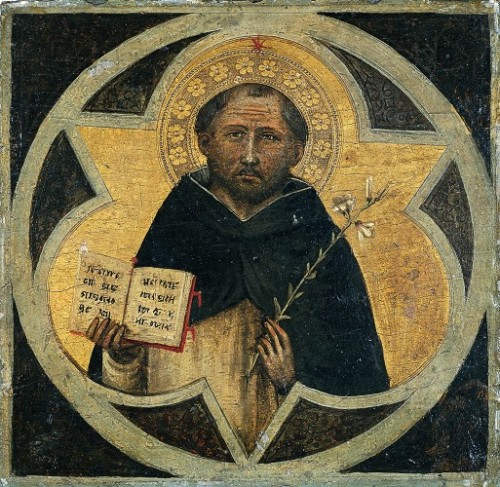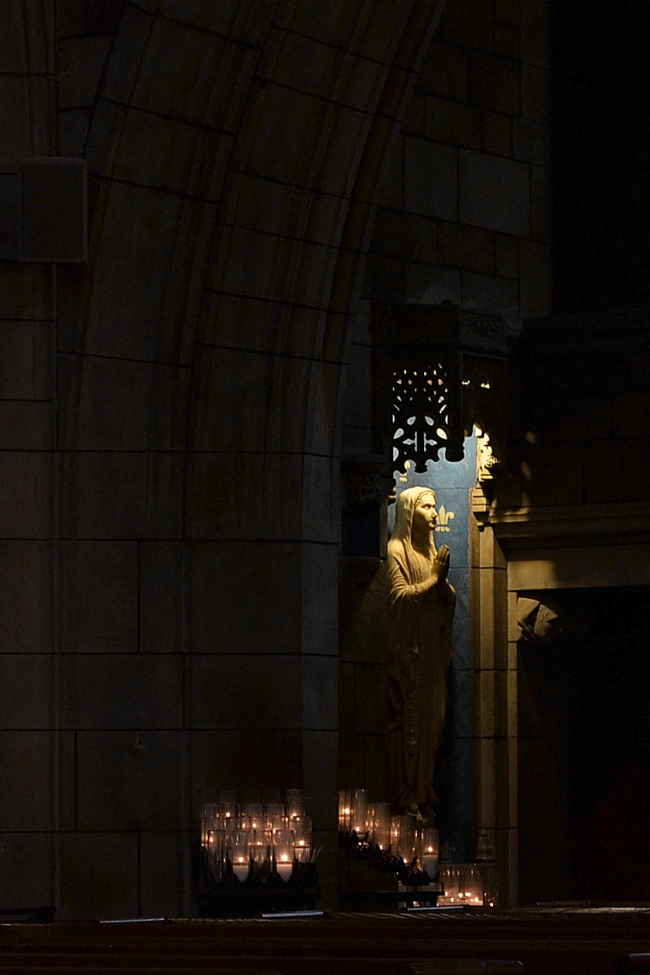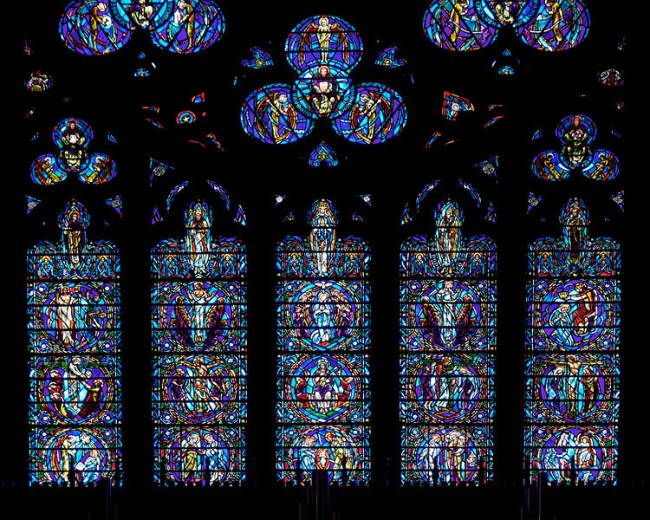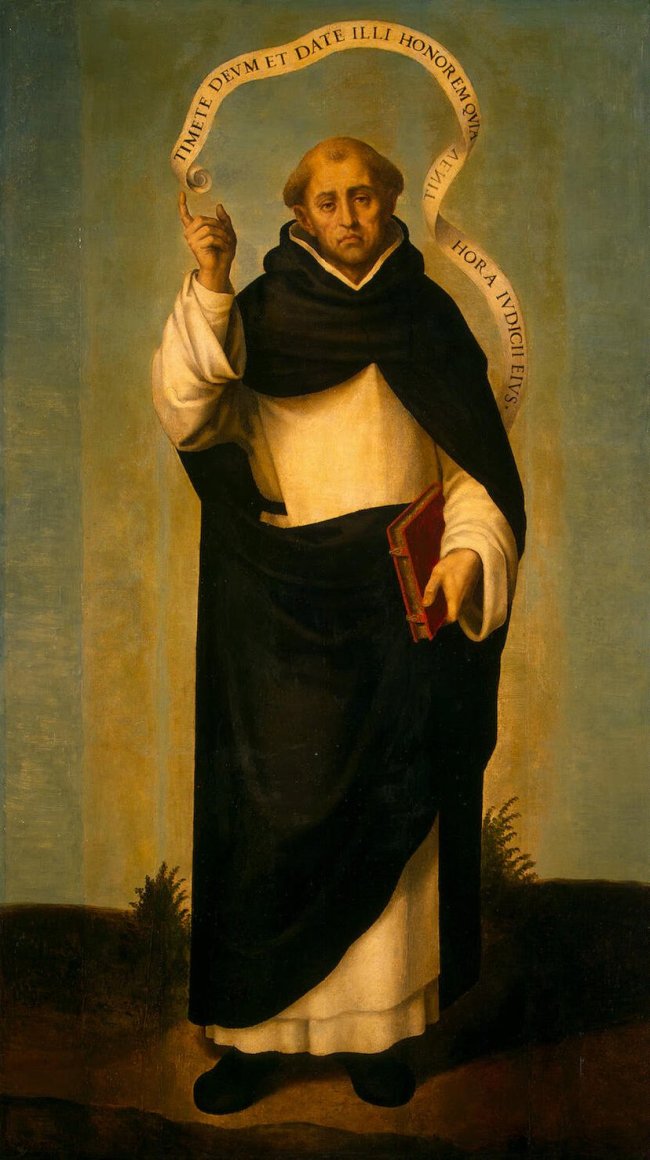
“All these people, and many others from Fanjeaux, asserted to a man that they had never seen anyone so holy and so good.” – Process of Canonization Toulouse, n. 19
The name Dominic translates to “man of God,” or “belonging to God.” Could any name be more apropos for this medieval saint? The life of St. Dominic de Guzman overflows with examples of his love for God, and the men & women he felt called to serve as a priest. It is said that when he celebrated Mass as a Canon Regular, tears could be seen coming down his face as he elevated the Eucharist. When he spoke, his brethren recall his words being directed “to God or about God.” On pilgrimages, he often brought the Gospel of St. Matthew with him, & was totally immersed in the Word of God. There are many anecdotes that I can give about this man that testify to his holiness, but I’m especially interested in sharing why I love St. Dominic & his Order of Friars Preachers.
When St. Dominic was 7 years old his parents, Bl. Jane of Aza & Don Felix de Guzman, left him in the care of an elder priest to start his catechesis in the Roman Catholic tradition. He learned how to read, write, & pray. All three, especially the latter, would become an indispensable part of his life. At 14, he began his studies of the humanities & sacred theology. It’s during this period, that St. Dominic grew to know & love God by his incessant reading of Sacred Scripture, which resulted in him knowing long passages of Scripture from memory. This would serve him well later in life, as he would rely on the Scriptures during his itinerant preaching throughout Europe at the turn of the 13th Century. Around the age of 25, feeling called to the priesthood, Dominic became a Canon Regular in Osma, Spain. As a Canon priest, St. Dominic celebrated Mass, lived a simple common life with his fellow Canons & chanted the Liturgy of the Hours several times a day in the cathedral. One can only imagine how joyful this life was for the young priest.

“Four canons with Sts Augustine and Jerome by an open grave, with the Visitation.”
In the year 1203 or 1204, Prince Ferdinand was to be wed & asked Bishop Diego de Acebo to find him a bride in Denmark. Bishop Diego asked his Canon, St. Dominic to accompany him on the journey. Dominic obliged. It was this trip, this pilgrimage, that changed Dominic’s life forever. During his travels throughout Europe, he encountered many heretics, who held beliefs of varying levels of absurdity. One of the most prominent groups were the Albigensians. In short, they believed that all things that were spiritual in nature were good, and all things that were physical were evil. This belief was, & continues to be problematic because the Scriptures tell us, “God called the dry land Earth, and the waters that were gathered together he called Seas. And God saw that it was good.” (Genesis 1:10) Thus, the beliefs of the Albigensians could not be true because we are made of both physical matter (our bodies) & spirit (our souls,) we are one, made in the image & likeness of God.
The numerous encounters that Dominic had with the Albigensians deeply saddened him. Instead of being filled with pride because of the many graces that was given to him, he was filled with compassion & love for these people. Dominic wanted to bring them out of heresy, & into the truth of Jesus Christ & His Holy Church. There’s one story of when St. Dominic & the Bishop needed a place to stay for the night and stumbled upon an inn during their travels. Somehow, St. Dominic discovered that the innkeepers theology was off kilter & he was indeed, a heretic. St Dominic patiently & lovingly “argued the case with the innkeeper point by point.” They stayed up all night talking, debating each other, challenging each other. By day break, the innkeeper decided to come back to the Catholic faith.

“Dominic answers the arguments of his opponents in order, counting off on his fingers. At the bottom of the fresco, black and white dogs, representing Dominicans, rescue sheep from wolves who are devouring them. In the middle ages the dog was the traditional symbol of the preacher: he barks against error, chases off false shepherds and robbers, and heals with the lick of his tongue.”
This early preaching, traveling throughout Europe on foot (which were bare in Dominic’s case,) became the top priority for Dominic & his companions. Dominic knew the salvific power of the Gospel & wanted to share it with everyone he came in contact with. The fact that these men (two Cistercians now accompanied St. Dominic & Bishop Diego) were poor, chaste, intelligent, and passionate about the Gospel made for very effective evangelization. Thoughts began to brew regarding an official Religious Order devoted to “preaching of the Gospel for the Salvation of Souls.” In the year 1215, seeing the good that these men were doing by spreading the faith, Bishop Foulques of Toulouse “signed a Charter approving the ‘regular life’ of the new community and formally appointing each of it’s members a preacher in his diocese.” This was great news, but not enough to be deemed an official Religious Order in the eyes of the Church. Well, all that changed in the Winter of 1216 when Pope Honorius III approved the Order, which was to be called the “Order of Preachers.”
In many ways, the Dominican friar is a hybrid between a parish priest & a monk. They live in houses known as priories, living under the Rule of St. Augustine. Dominicans are “Religious,” so they take a vow of obedience (which include the other evangelical counsels of poverty & chastity) upon entering the Order. Like parish priests, they celebrate Mass, pray the liturgy of the hours, and are involved in a number of active ministries. Campus ministry, hospital chaplaincy, and teaching at the high school & college level are some of the things they do outside of the parish. They differ from monks, in that, they do not take a vow of stability, so they are not vowed to stay in their religious community at all times. That said, the most important component to the Dominican charism is preaching. They are an Order of Preachers & they do it well, if I may say so myself. What informs, educates, and sanctifies this preaching, is a life dedicated to prayer, study, & contemplation. The Dominican must first be configured to Christ before he can preach God to others. St. Thomas Aquinas, a towering theologian and Doctor of the Church, asserts that Dominicans “contemplata aliis tradere,” which translates to “[to contemplate God] and to give others the fruit of contemplation.“

The Brethren
I have a deep love for Gothic architecture, I’ve loved it for many years now. A friend of mine, who knows how much I appreciate this style, took me to one of the finest examples of Gothic architecture in the city of New York, the Church of St. Vincent Ferrer. A few years later, when I decided to become a Roman Catholic, I returned to the beautiful church on Lexington Avenue, which happened to be staffed by Dominican friars. This was my first exposure to a male Religious Order in the Church. I recall staring at their habits in awe, thinking, “they’re priests? But they’re not wearing the little collar?” Fortunately, my knowledge about the Church & the varied ways one can serve her grew with time. I was thinking about a priestly vocation in the Archdiocese of New York & Religious Life with the Dominicans, although the latter was slightly more intimidating.
Mass is available everyday at St. Vincent’s, and prior to Mass, one can hear the friars chanting the Liturgy of the Hours in the friars chapel, which is to the right of the altar. When I would arrive for Mass at 5:30PM, I would often hear them finishing up their prayers. Usually, it would be the last few lines of the “Our Father.” One day, I decided to come 30 minutes early so I could watch them pray the entire office. I didn’t want to participate with them, and even if I did, I didn’t know how, plus I didn’t have a breviary. I just wanted to watch them do their thing. Just a few moments before 5:00PM, the friars walked into the friars chapel. They genuflected towards the Blessed Sacrament & sat in the choir stalls, sitting across from one another. One friar had his hands on his head, another had his hood on, all of them were silent. Shortly after 5:00PM, they all stood up and chanted, “Oh God, come to my assistance, Lord make haste to help me, Glory to the Father and to the Son, and to the Holy Spirit, as it was in the beginning is now & will be forever amen. Alleluia.” Wow! I thought the back of my head was going to explode. I had never seen or heard anything like this before. It was so exciting to see & witness. They continued their prayers and then proceeded to sing a hymn in unison, so beautiful. It seemed as though with each passing minute, my heart rate began to increase exponentially. After the Office of Readings, the brothers chanted the psalms back & forth using an ancient psalm tone. I recall staring through the grill, admiring these men who’s lives are entirely devoted to God, singing God’s praises without shame or fear. It was so moving, and before long, tears began to fall from my face. The last portion of Vespers was the Canticle of Mary, also known as the Magnificat. “My soul proclaims the greatness of the Lord, my spirit rejoices in God, my Savior. . .” they gently, yet firmly chanted. At this point, I was finished. I was basically a giant puddle of tears and snot, absolutely convinced that nothing on the face of this earth could be more compelling than a Dominican vocation.

Some of the Student Br.’s currently studying for the priesthood at the Dominican House of Studies in Washington, D.C.
Since that wonderful day in May, I’ve been to a number of vocation events here in New York City & in Washington, D.C. at the Dominican House of Studies. They have all been illuminating, fun, and encouraging. In my interactions with the Student Br.’s, I’ve noticed much diversity among the Studentate. Some men are quiet and reserved, while others are chatty & outgoing. Most of them, in my opinion, are a mixture of both personality types. Despite the diversity in temperament, there are qualities that are consistent with each Student Br. that I meet; they want to share the Good News of Jesus Christ in a way that is dynamic, honest, and steeped in the rich tradition of the Dominican Order. How could I refuse this wonderful vocation? I feel so fortunate to have found something that I truly feel called to. Thank you, God!
The title of this essay is “Falling in Love.” I don’t think I could come up with a stronger sentiment that describes how I feel about this Religious Order. I love the Order because of their love for souls. I love the Order because of their commitment to a life of study. I love the Order because of their almost 800 year tradition of scholarship (have you read St. Thomas Aquinas?), artistry (you should really check out Fra Angelico. Did I mention that he was a Dominican?), and long list of incredible saints (three of them are Doctors of the Church!) Lastly, I love them because I believe that God has led me to the Dominican Order, & in His Divine Providence, he knew that a Dominican vocation would make me happy, and that it would be the best way for me to serve Him & His Holy Church.
I would like to leave you with a quote by the 20th Century Dominican Cardinal, Fr. Yves Congar, O.P.
On his life as a Dominican, Fr. Congar said. . .
“The Order of Preachers is dedicated to the service of the Gospel, especially under the aspect of truth. I’ve loved it and still love it, in the way one loves a person.”
✠
 “All these people, and many others from Fanjeaux, asserted to a man that they had never seen anyone so holy and so good.” — Process of Canonization Toulouse, n. 19
“All these people, and many others from Fanjeaux, asserted to a man that they had never seen anyone so holy and so good.” — Process of Canonization Toulouse, n. 19



![Edvard Munch - "The Scream" [Detail] (1893)](https://kareemonelson.wordpress.com/wp-content/uploads/2014/12/scream.jpg?w=500&h=324)









